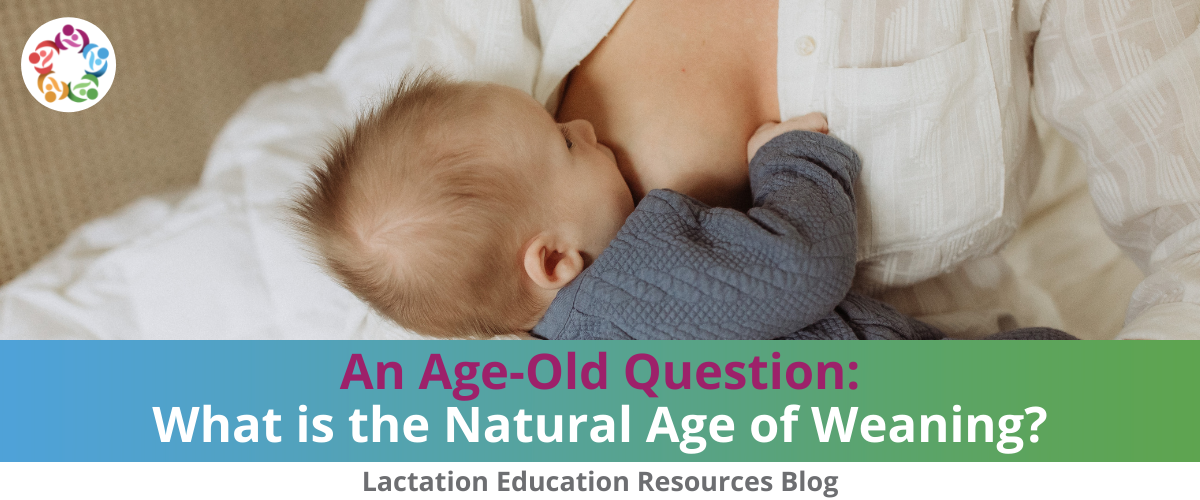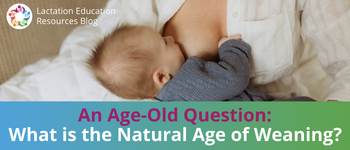An Age-Old Question: What is the Natural Age of Weaning?

If you’re fascinated with lactation and human milk, you’ve probably considered this question:
What is the natural age of weaning in humans?
Cultures around the world and across time have varied so widely in duration of breastfeeding/chestfeeding. Is there actually an answer to the question, “What is the biological norm?”
There are certainly many lenses to apply to the query.
Historians look to the past: Before modern life and technology got involved, how long did our ancestors nurse before they weaned?
Ancient texts contain a few clues.
In Greece, the writings of Aristotle (384-322 BC) include references to babies breastfeeding for 12 to 18 months, or until the parent’s menstrual cycle returned.
Ancient Hebrew writings, however, commonly describe children as still nursing at 3 years of age.
Where else have experts looked for ideas?
Anthropology Offers Answers
When anthropologists ask when humans would naturally wean, they consider the age at which key milestones are reached, such as doubling birth weight or the eruption of all permanent teeth.
Throughout the anthropology literature, the following benchmarks have all been used as possible markers for the “normal” length of lactation:
- Age at which the infant reaches four times their birth weight. In humans, this happens at 2-3 years.
- Age at six times the length of gestation (4.5 years of age).
- Age when molars first erupt (usually years or older).
- Age when all of the baby teeth have fallen out (5-6 years or even later).
Biology Takes a Stab
The field of comparative biology has attempted to arrive at an age of natural weaning for humans by looking at what our relatives, other mammals, do.
The idea is that rabbits aren’t concerned about what their friends or extended family members think and they aren’t getting advice from Google. So asking how long they nurse their young could provide hints about what our species might do under more natural circumstances.
What numbers come to the surface through this lens?
Well, rabbits nurse their young for 28 to 35 days.
For cows, it’s 180-240 days.
How does that relate to humans?
Try this: Baby rabbits double their birth weight in six to seven days–so they are nursing for four times that long.
Humans double their birth weight, on average, in 105 to 126 days. Multiply that by four, and to keep up with the rabbits, human babies would need to nurse well past their first year of life.
To nurse as long as cows, we’d have to go further. A calf doubles its birth weight in approximately 36 days, meaning cows nurse six-and-a-half times as long as it takes to achieve that.
A human baby would have to nurse until about age 2 to reach that benchmark.
Other studies of a wide range of mammals arrived at this calculation: Typical weaning time in days = 2.71 times the weight of the adult female in grams.
Run this formula on humans, and you get an average weaning age of 2.8-3.7 years, depending on the average body weight within a specific population.
The Question Behind the Question
As fascinating as pondering the biological norm for weaning age is for those of us who adore lactation, chances are, when a family asks you questions about weaning, that’s probably not what they’re going to ask.
When you’re working with parents of older babies and toddlers, the questions are apt to sound more like these:
“My friend weaned her eight-month-old, and now he sleeps through the night. I’m still nursing my 15-month-old all night! Should I wean?”
“My two-year-old wants me to hold her constantly. My mother-in law said breastfeeding is making her clingy and keeping her from being independent. Is she too old to still be nursing?”
As a lactation care provider, how can you answer?
Although information about rabbit lactation might help, chances are, they’re looking for something a little bit different.
If you listen closely, they could be wondering, “Is chest- or breastfeeding the reason for the parenting challenge I’m currently facing, and will it stop if I wean?”
They could also be asking, “How can I continue providing my milk for my older baby or toddler, in the face of less-than-supportive circumstances? And how can I communicate about it with people in my life who aren’t on board?”
Or maybe, for them, the time has come to wean, and they’re asking, “Is it okay to wean, if that feels right to me … and how do I do it?”
Listening and Helping
Here are some important steps to take when you are exploring questions about weaning with a family.
- Know your own biases. What experiences, personally and culturally, have you had that have shaped your beliefs about when babies should wean?
- Understand your population. What are the cultural norms within the groups you serve?
- Keep this particular family’s needs centered. The most important step you can take is to listen to your client’s questions and thoughts about weaning with an open mind and heart, and to ask them what their goals and desires are.
Take these steps, and you’ll know how best to help.
(And whether information about rabbit lactation should be part of your answer!)
Ready for more information about chest- and breastfeeding older babies and toddlers? Weaning is just one of the rich topics explored in our new course “Human Milk for Older Infants and Toddlers.”
Taught by physician-IBCLC Sally Wineholt, a family medicine practitioner whose patients include many parents and older nurslings, the course also covers benefits for parent and baby, common difficulties, introduction of complementary foods, and more.
Earn 1.5 L-CERPs, 1.5 Nursing Contact Hours, or 1.5 CMEs when you complete this course.

If you’re fascinated with lactation and human milk, you’ve probably considered this question:
What is the natural age of weaning in humans?
Cultures around the world and across time have varied so widely in duration of breastfeeding/chestfeeding. Is there actually an answer to the question, “What is the biological norm?”
There are certainly many lenses to apply to the query.
Historians look to the past: Before modern life and technology got involved, how long did our ancestors nurse before they weaned?
Ancient texts contain a few clues.
In Greece, the writings of Aristotle (384-322 BC) include references to babies breastfeeding for 12 to 18 months, or until the parent’s menstrual cycle returned.
Ancient Hebrew writings, however, commonly describe children as still nursing at 3 years of age.
Where else have experts looked for ideas?
Anthropology Offers Answers
When anthropologists ask when humans would naturally wean, they consider the age at which key milestones are reached, such as doubling birth weight or the eruption of all permanent teeth.
Throughout the anthropology literature, the following benchmarks have all been used as possible markers for the “normal” length of lactation:
- Age at which the infant reaches four times their birth weight. In humans, this happens at 2-3 years.
- Age at six times the length of gestation (4.5 years of age).
- Age when molars first erupt (usually years or older).
- Age when all of the baby teeth have fallen out (5-6 years or even later).
Biology Takes a Stab
The field of comparative biology has attempted to arrive at an age of natural weaning for humans by looking at what our relatives, other mammals, do.
The idea is that rabbits aren’t concerned about what their friends or extended family members think and they aren’t getting advice from Google. So asking how long they nurse their young could provide hints about what our species might do under more natural circumstances.
What numbers come to the surface through this lens?
Well, rabbits nurse their young for 28 to 35 days.
For cows, it’s 180-240 days.
How does that relate to humans?
Try this: Baby rabbits double their birth weight in six to seven days–so they are nursing for four times that long.
Humans double their birth weight, on average, in 105 to 126 days. Multiply that by four, and to keep up with the rabbits, human babies would need to nurse well past their first year of life.
To nurse as long as cows, we’d have to go further. A calf doubles its birth weight in approximately 36 days, meaning cows nurse six-and-a-half times as long as it takes to achieve that.
A human baby would have to nurse until about age 2 to reach that benchmark.
Other studies of a wide range of mammals arrived at this calculation: Typical weaning time in days = 2.71 times the weight of the adult female in grams.
Run this formula on humans, and you get an average weaning age of 2.8-3.7 years, depending on the average body weight within a specific population.
The Question Behind the Question
As fascinating as pondering the biological norm for weaning age is for those of us who adore lactation, chances are, when a family asks you questions about weaning, that’s probably not what they’re going to ask.
When you’re working with parents of older babies and toddlers, the questions are apt to sound more like these:
“My friend weaned her eight-month-old, and now he sleeps through the night. I’m still nursing my 15-month-old all night! Should I wean?”
“My two-year-old wants me to hold her constantly. My mother-in law said breastfeeding is making her clingy and keeping her from being independent. Is she too old to still be nursing?”
As a lactation care provider, how can you answer?
Although information about rabbit lactation might help, chances are, they’re looking for something a little bit different.
If you listen closely, they could be wondering, “Is chest- or breastfeeding the reason for the parenting challenge I’m currently facing, and will it stop if I wean?”
They could also be asking, “How can I continue providing my milk for my older baby or toddler, in the face of less-than-supportive circumstances? And how can I communicate about it with people in my life who aren’t on board?”
Or maybe, for them, the time has come to wean, and they’re asking, “Is it okay to wean, if that feels right to me … and how do I do it?”
Listening and Helping
Here are some important steps to take when you are exploring questions about weaning with a family.
- Know your own biases. What experiences, personally and culturally, have you had that have shaped your beliefs about when babies should wean?
- Understand your population. What are the cultural norms within the groups you serve?
- Keep this particular family’s needs centered. The most important step you can take is to listen to your client’s questions and thoughts about weaning with an open mind and heart, and to ask them what their goals and desires are.
Take these steps, and you’ll know how best to help.
(And whether information about rabbit lactation should be part of your answer!)
Ready for more information about chest- and breastfeeding older babies and toddlers? Weaning is just one of the rich topics explored in our new course “Human Milk for Older Infants and Toddlers.”
Taught by physician-IBCLC Sally Wineholt, a family medicine practitioner whose patients include many parents and older nurslings, the course also covers benefits for parent and baby, common difficulties, introduction of complementary foods, and more.
By accepting you will be accessing a service provided by a third-party external to https://www.lactationtraining.com/
